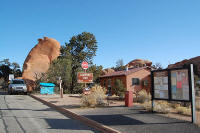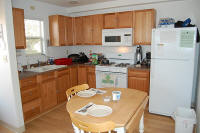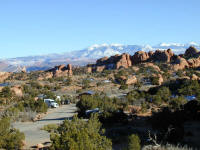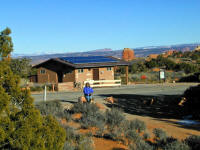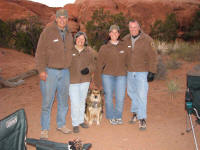|
|
||
|
|
|
|
|
|
||
Workamping
|
|
|
|
|
|
Copyright © 2002-2017 John Mayer. All rights reserved. For reuse policy see Reuse Policy We workamp in the summer. We typically decide on an area we would like to see in depth. We then find a job in that area - this gives us a "free" base to see the area from, and we enjoy the work. We have generally worked in commercial campgrounds, and have enjoyed the experience. We don't do it for the money, but it does minimize expenses. You would find it difficult to live on a workamping job if you did not have supplemental income. Additional info on workamping can be found at Workamper News. Our workamping resume is available here. Since 2005 we have worked at Diamond Campground in Woodland Park, CO. For us, it is a great place to work with lots to do during our free days. The owners treat their workamper's great. We work a 2 on/4 off schedule so there is plenty of time to do things. For some pictures of Diamond and some more details of our amenities take a look at our Picasa Album Diamond Campground. Be sure to view it via the slideshow to see our captions. Probably the best description of Workamping, and the factors surrounding it that a potential workamper would want to understand, are at Howard and Linda Payne's RV-Dreams website. They also cover some of the tax implications of workamping. Kirk and Pam Wood probably have more experience with volunteer positions than any other fulltimer. They have been volunteering almost continuously since beginning to fulltime in their RV in 2000. Last I counted they had worked 23 separate positions - all as volunteers. They describe each of these on their website, The Adventure Begins Here. If you want to get a feel for volunteering, there is no better source of information that I am aware of.
Workamping (Volunteering) At Arches National Park
Arches National Park is one of the
most unique and beautiful parks in the west. It is located in
The campground at Arches National
Park (NP) is located 18 miles from the entry gate to the park. It is a
“primitive” campground of 54 sites, with three restrooms and dishwashing
sinks. There are no hookups for the campers, and water is only available
at the restrooms. There is no dump station in the Park; the nearest dump
station is in
Our experience with this system has been positive – we have no trouble in using all the normal RV items, including electric hair dryers, and all of our TV, lighting and computer needs. We use the microwave for short heating tasks, and use our outside gas grill for baking and in place of the convection oven. We do not bake in the convection oven. I even leave our truck plugged into the electric and on a trickle charger.
If necessary, you could supplement your power supply with your own generator. You would be restricted to running this during the normal generator hours; 0800-1000, 1600-2200 hrs.
Site 35 (the host RV site) was rehabilitated for the 2008 season. It now has a very nice concrete pad, and enough room for any size rig, including a 45' motorhome. Our 38’ fifth wheel fits in just fine, with room in front of it for our semi-truck and Jeep. A 40’ fifth wheel would fit the same as our 38’. There is plenty of room for a fire pit, chairs, picnic table, etc. to the curb side of the RV. The site has a nice fire ring, but you must obtain your own firewood. Usually, there are enough scraps left in the campground to support at least four fires a week.
If you would like to be campground hosts at Arches I would recommend calling the park DIRECTLY, and ask for the volunteer coordinator.
The “Work”
As with most campground hosting jobs, your primary responsibility is to act as a presence in the campground, perform fee compliance, and help campers with questions. This is especially the case in Arches, where the campground is 18 miles from the visitor center.
The campsites are divided into
“first come, first served” and reservation sections. The reservations
are handled outside the Park system through Recreation.gov, so the Park has
little control over the reserved sites other than helping people find
them. The Hosts do have control over the non-reservable sites (called
Category 1 sites). Because the campground is so far from the entry gate,
and to avoid the problem of people driving eighteen miles only to find a
full campground, the Park requires that people obtain a camping site
envelope at the park entrance gate. These envelopes are given out at
0730 on an available basis. Leftover sites (not given out at the 0730
“lineup”) are given out at the gate as people request campsites. There
are only 24 sites available via this method (sites 25 to 54 are on the reservation system). In order for the
The Host’s primary job is to maintain a compliance sheet containing all campsites. They collect registration info from the tickets at the campsites, or directly from the campers. This includes license plate number, number of people, number of tents, etc. Providing this info, pulling the tickets in the morning, and calling in the available sites at 1800 hrs means the host needs to make a pass through the campground at least 3 times a day – 0630 hrs., sometime mid-day, and 1600 hrs. At 2000 hrs we generally walk the campground to ensure compliance with generator hours. At 2200 hrs I will walk portions of the campground to ensure quiet hours compliance if I know I have "rambunctious" campers. There is no requirement to walk the campground – you can drive the cart if you want - but the 0630 pass is best done on foot, since you have to look at every site box. The campground “round” is about 1.2 miles – the 0630 round takes about an hour. We combine the 0630 round with walking our dog. This is the “hardest” part of the job, but has some great side benefits – such as seeing spectacular sunrises over the red rock. One side note: the campground is hilly - you need to be in at least moderate physical condition in our opinion.
The duty cycle is an alternating 3 or 4 days on, followed by 4 or 3 days off – so you work basically half a week. When on duty you are responsible for all aspects of the campground – site compliance, selling firewood, answering questions, handling problems and emergencies – 24hrs a day. Generally, you can get to bed by 2200 hrs. but in rare instances you may be up later. People asking for firewood are rare after 2100 hrs. Generally, any late night “knocks on the door” are because of 1) “Someone is in my campsite” or 2) Noise. This does not happen often, in our experience, and you will learn how to minimize it.
When on duty, only one of you has to be at the campground – the other can go to town and shop, wash clothes, etc. However, the 0630 round is best done together. When not performing other duties the on-duty hosts can relax at their site, work on their rig, etc. But one must remain available in the campground.
There is no requirement to perform maintenance, clean fire pits, maintain or clean restrooms, etc. We pick up trash where we see it, and will remove bottles and trash from fire pits when we notice it.
Communication to the rest of the Park system is via commercial radio. There is a repeater on the La Sal Mountains so reception is generally very good. The radios are high quality and generally clear and understandable. You will have to learn proper radio protocol. In emergencies your radio is your primary method of communication. Cell phones will reliably work from the campground only if you have an external antenna. Without a cellular amplifier you will have intermittent service at the cabin even with an external antenna. From site 35 only an external antenna is needed. If you have a personal requirement for constant cell phone availability I strongly suggest you buy an amplifier and external antenna. Look in the Communication section for information on your options. Internet access with a Verizon cellular air card works fine from Site 35 with an amplifier. However, the high speed available throughout the main areas of Moab is slower at the campground. Speeds of 300kbps are about average.
Emergencies and backup support is
handled by the Park Law Enforcement Rangers. They are available 24 hrs a
day, but the reality is that later at night you may not be able to directly
contact them via radio. Even during the day they may be as many as 18
miles away. In a true emergency you have two options if you can not
directly contact Law Enforcement Rangers. The first is to use your cell
phone and dial 911. This puts you in direct contact with County
emergency dispatch. They are familiar with the Park system, have the
contact numbers for the Rangers, and will directly contact them on your
behalf or provide other assistance as required. You can also contact the
|
|
|
|
||
